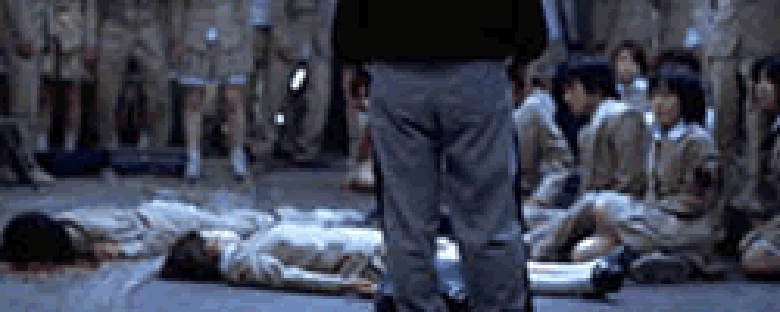Reviews
Kinji Fukasaku
Japan, 2000
Credits
Review by Rumsey Taylor
Posted on 10 July 2004
Source Tartan Video DVD
Battle Royale refers to a survival contest, in the vein of The Running Man, Lord of the Flies, and The Most Dangerous Game, in which ninth grade students are sent to an island and given three days to reduce their number to one. The deaths, shots, blows, slashes, and spurts of blood all frequently present, Battle Royale is ostensibly an exercise in exploitation.
This violence is given an attempted justification. The film criticizes overpopulation, student delinquency, and social competition — each told through the metaphor of the title contest.
According to its prologue, a near-future Japan faces massive student disinterest. Schools are boycotted in droves and a collapse in the educational system seems imminent. The government passes a radical measure: The Millennium Education Reform Act (the BR Act).
Each year a class of ninth-grade students is selected at random and sent to a deserted island. Each is given food rations, a random weapon (“To eliminate natural advantages”), a map, and three days to survive. To complicate the strife, a collar is affixed on each unwilling participant. It beacons their pulse and conversations to a hidden control room and will explode if the wearer attempts to remove it.
The opening of film finds a rush of media figures and soldiers towards a jeep, containing the winner of the past Battle Royale. “It’s a girl!” shouts a reporter. The group encloses on the victor, and the camera zooms on the girl’s countenance: she is doused with recent splatters of blood, clutches a stuffed animal, and is grinning sheepishly. It is a successfully frightening image.
Prior to the following contest, the histories of some of the students are given. Though no particular history is successfully married to the subject, the action does well to strengthen the film’s characters. The body count, though largely numbered by expendables, is comprised of characters we may know and sympathize.
The students awaken (after being unknowingly drugged and transported to the island) and find themselves in a classroom, strewn with cold fluorescent lights. They open a window and find helicopter spotlights pointed at them. The class is joined by two “transfers”: one sports a bandana, the other a frock of messy hair, both pose as an impending menace. Once informed of their ensuing task the class panics. Their instructor throws a knife, resulting in the first corpse, symbolically — and violently — placing a noticed period after his order for them to be quiet.
The students leave in their class order — as they exit, a subtitle displays their name and number. This technique lends an identity to each player. This is a laudable action, otherwise, the students’ deaths (and not their identities) would be emphasized.
The violence in Battle Royale is often grisly (each death is conveyed and often seen in detail). However, the film honors The Evil Dead lesson in anatomy, as bodies are filled with an amount of blood that exceeds their suspected capacity — and most of it is emptied on screen. This does not underline the violence by any means. Contrarily, it lightens it, as does the exaggerated sounds of punches, expunged knives, and gunshots. This de-emphasized violence furthers the film’s cynical parody of contemporary politics and culture in Japan.
In the same manner as the student’s introductions their deaths bear a subtitle. Fans have dubbed this technique as “score cards” that display the student’s name, time of death, and remaining participants. Battle Royale, despite its function as an extension of governmental control, is a game.
Though the controversy of Battle Royale may be discounted, it is a film that will likely never invite an American release. It debuted in Japan in 2000 and was branded with the country’s most extreme rating. Director Fukasaku released a trimmed version of the film, excising most of the violence, in an effort to forward the film’s intended relevance to the film’s targeted age contingent. The edited version was also popular. Politically Battle Royale is no different from Fight Club in its treatment of fascism, and the popularity of the latter film suggests that Battle Royale would encounter a similar reception domestically.
Teenagers in film have their plights magnified, whether they’re seeking identity or trying to get laid. Those in Battle Royale are no different. Though their task — to stay alive — is more complicated, their strife is infused with the same level of drama. As an entry in teenage film, Battle Royale functions to display the wide extent of a genre comprised of thematically impotent and derivative entries. Imagine a film that borrows equally from Hong Kong action flicks and The Breakfast Club.
We don’t do comments anymore, but you may contact us here or find us on Twitter or Facebook.



